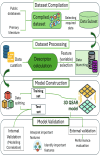A Review of In Silico and In Vitro Approaches in the Fight Against Carbapenem-Resistant Enterobacterales
- PMID: 40205812
- PMCID: PMC12078764
- DOI: 10.1002/jcla.70018
A Review of In Silico and In Vitro Approaches in the Fight Against Carbapenem-Resistant Enterobacterales
Abstract
Objectives: The rise in carbapenem-resistant Enterobacterales (CRE) has reinforced the global quest for developing effective therapeutics. Traditional drug discovery approaches have been inadequate in overcoming this challenge due to their resource and time constraints.
Methods: English literature was searched by structured queries related to our review between January 1, 2020, and December 31, 2024.
Results: The key resistance mechanisms in CRE, such as enzymatic hydrolysis, decreased permeability, and efflux pump overexpression, have been examined in this review. Computational technologies have become pivotal in discovering novel antimicrobial agents with improved accuracy and efficiency. Besides this, the review highlights the advances in structure- and ligand-based drug discovery approaches for identifying potential drugs against CRE. Recent studies demonstrating the use of such in silico techniques to develop targeted drugs against CRE have also been explored. Moreover, this review also underscores the significance of integrating both in silico and in vitro techniques to counter resistance in Enterobacterales, supported by the latest studies. However, these promising computational technologies have a few major drawbacks, such as a lack of standardized parameterization, potentially false positives, and the complexity of effective clinical translations. The drug regulatory barriers also restrict the progress of new antimicrobials for market approval.
Conclusion: The use of computational technologies for antimicrobial inhibitor discovery is gaining popularity, and it can be expedited by refining computational techniques and integrating them with reliable in vitro validation. The use of innovative hybrid in silico and in vitro technologies is the need of the hour to tackle CRE and mitigate the global threat of antimicrobial resistance.
Keywords: CRE; Enterobacterales; antimicrobial discovery; computational pharmacology; in silico validation; virtual screening.
© 2025 The Author(s). Journal of Clinical Laboratory Analysis published by Wiley Periodicals LLC.
Conflict of interest statement
The authors declare no conflicts of interest.
Figures






References
-
- Mmatli M., Mbelle N. M., Maningi N. E., and Osei Sekyere J., “Emerging Transcriptional and Genomic Mechanisms Mediating Carbapenem and Polymyxin Resistance in Enterobacteriaceae: A Systematic Review of Current Reports,” MSystems 5, no. 6 (2020): e00783‐20, 10.1128/msystems.00783-20. - DOI - PMC - PubMed
-
- Suay‐García B. and Pérez‐Gracia M. T., “Present and Future of Carbapenem‐Resistant Enterobacteriaceae Infections,” in Advances in Clinical Immunology, Medical Microbiology, COVID‐19, and Big Data, 1st ed., ed. Bawa R. (Jenny Stanford Publishing, 2021), 435–456.
Publication types
MeSH terms
Substances
LinkOut - more resources
Full Text Sources
Medical

